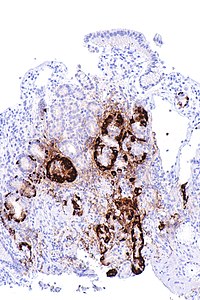
Photo from wikipedia
Background: Childhood anaemia affects 1.8 billion people globally. Little is known about the long-term impact of mass drug administration (MDA) for the control of soil-transmitted helminthiases (STH) on the spatiotemporal… Click to show full abstract
Background: Childhood anaemia affects 1.8 billion people globally. Little is known about the long-term impact of mass drug administration (MDA) for the control of soil-transmitted helminthiases (STH) on the spatiotemporal variation of anaemia prevalence and severity. We describe the long-term spatiotemporal impact of a 5-year STH MDA programme (2007–2011) on the prevalence of anaemia and anaemia severity in school-aged children (SAC) in Burundi. Methodology/Principal Findings: We used annual haemoglobin concentration and STH data collected during 2007–2011 in 31 schools in Burundi. Spatial dependence in prevalence and severity of anaemia was assessed using semivariograms. Bayesian geostatistical models were developed to (a) quantify the role of STH (adjusted for other anaemia determinants) in the spatiotemporal distribution of anaemia prevalence/severity, and (b) predict the geographical variation of both outcomes across Burundi. Adjusted population data were used to estimate the geographical distribution of the number of SAC at risk of anaemia and with low and moderate/severe anaemia. Infections with Ascaris lumbricoides and Trichuris trichiura were positively and significantly associated with childhood anaemia; hookworm infections were not. A significant decrease in anaemia prevalence, from 40–50% (2008) to 10–20% (2011) was predicted in western areas. The predicted prevalence of low-severity anaemia decreased from 40–50% (2008) to <20% (2011) in southern and eastern areas. Moderate/high-severity anaemia was concentrated in western regions of Burundi, with pockets of moderate/high-severity anaemia in central and northern regions in 2008. The overall number of predicted anaemic children decreased from 443,657 (2008) to 232,304 (2011), with a resurgence after MDA disruption in 2010 (to 480,605). Prevalence of low- and moderate-severity anaemia was higher in boys than in girls. Conclusions/Significance: Despite ongoing MDA, the prevalence of anaemia in SAC remained high and increased in certain parts of the country. It is recommended that MDA programmes targeting STH are complemented with specific anaemia interventions.
Journal Title: Tropical Medicine and Infectious Disease
Year Published: 2022
Link to full text (if available)
Share on Social Media: Sign Up to like & get
recommendations!